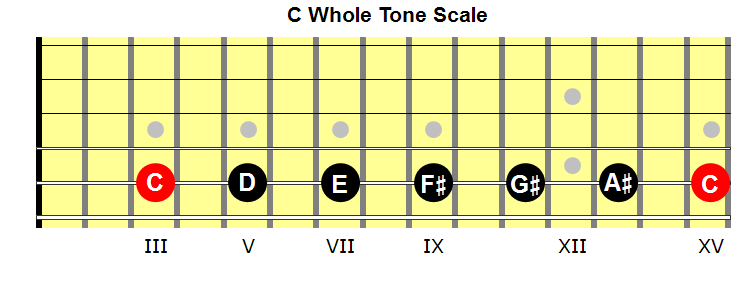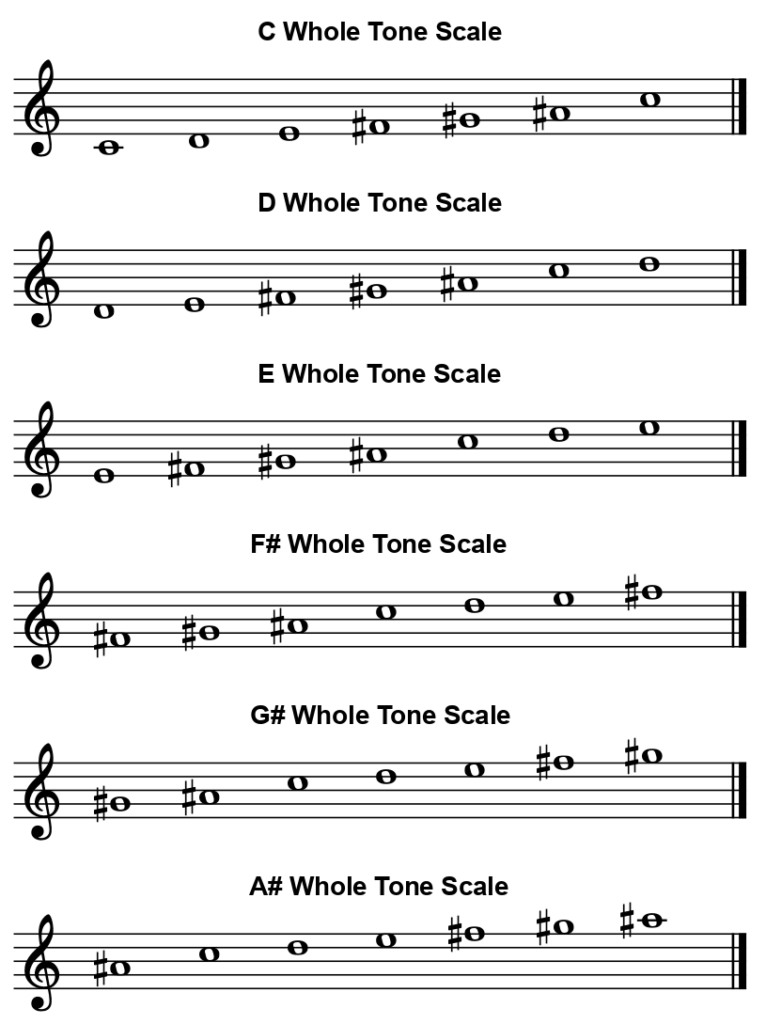The whole tone scale is a six-note, symmetrical scale constructed entirely with whole steps.
The scale’s interval structure is W W W W W W.
This post will analyze the whole tone scale. It will also provide a common fingering for the scale, along with instruction on how to play it on a guitar with any root note.
Constructing a Whole Tone Scale
We can construct a whole tone scale by starting on any note and adding five more notes, each one a whole step higher than the previous one.
C Whole Tone Scale
For example, if we start a whole tone scale on a C, the scale would contain the notes C, D, E, F#, G# and A#.
Fig.1 shows a C whole tone scale.
Fig.1

It is easy to see the pattern of whole steps if we play a C whole tone scale on one string on a guitar (fig.2).
Fig.2

If we start a C whole tone scale on the C on the fifth string, third fret, you can see that there is:
- A whole step between C and D.
- A whole step between D and E.
- A whole step between E and F#.
- A whole step between F# and G#.
- A whole step between G# and A#.
- A whole step between A# and C.
Enharmonic Equivalent Whole Tone Scales
There are really only two different whole tone scales:
- The C whole tone scale.
- The C# whole tone scale.
All of the other whole tone scales are enharmonic equivalents of one of those two scales.
C Whole Tone Scale
The following whole tone scales are enharmonic equivalents of a C whole tone scale:
- D whole tone scale.
- E whole tone scale.
- F# whole tone scale.
- G# whole tone scale.
- A# whole tone scale.
All six scales contain the same notes.
Fig.3 shows the six enharmonic equivalent whole tone scales.
.
Fig.3

C# Whole Tone Scale
The following whole tone scales are enharmonic equivalents of a C# whole tone scale:
- D# whole tone scale.
- E# whole tone scale.
- G whole tone scale.
- A whole tone scale.
- B whole tone scale.
All six scales contain the same notes.
Fig.4 shows the six enharmonic equivalent whole tone scales.
Fig.4

Whole Tone Scales on a Guitar
Fig.5 shows a common fingering for a whole tone scale.
Fig.5

This fingering will allow you to play a whole tone scale starting on any note:
- To play a C whole tone scale, start the pattern on the C on the sixth string, eighth fret (fig.6a).
- To play a C# whole tone scale, start the pattern on the D on the sixth string, 10th fret (fig.6b).
Fig.6

Soloing Application
The whole tone scale is used to solo over augmented triads and dominant seventh chords with an altered fifth scale degree.
All of the notes in those chords are contained in a whole note scale.
For example, all of the notes in the chords C+, C7(b5) and C7(#5) can be found in a C whole tone scale (fig.7, with the scale degrees labeled).
Some of the notes in the scale have been renamed enharmonically to match the correct spelling of the chords.
Fig.7


Related Posts
Related posts include:
